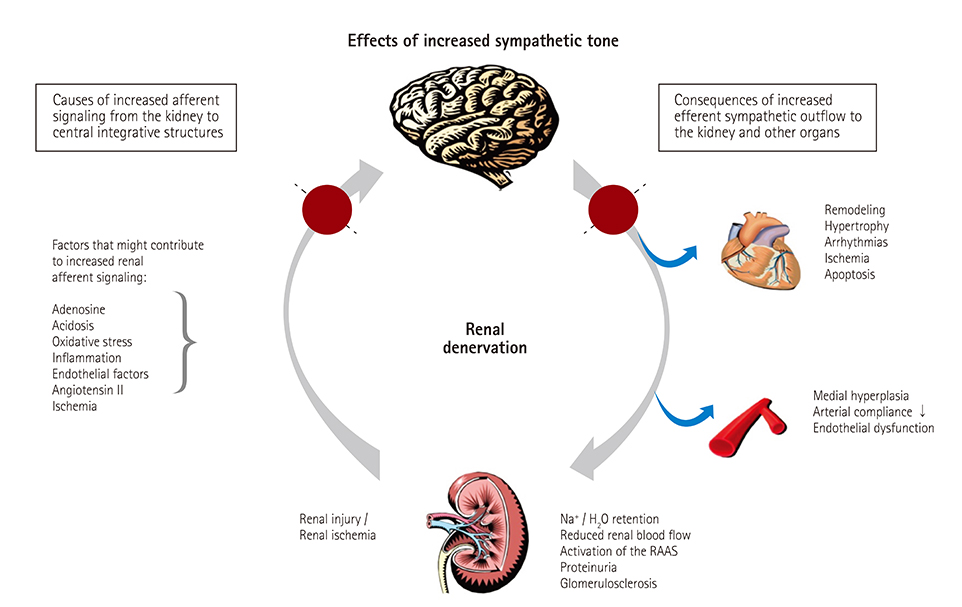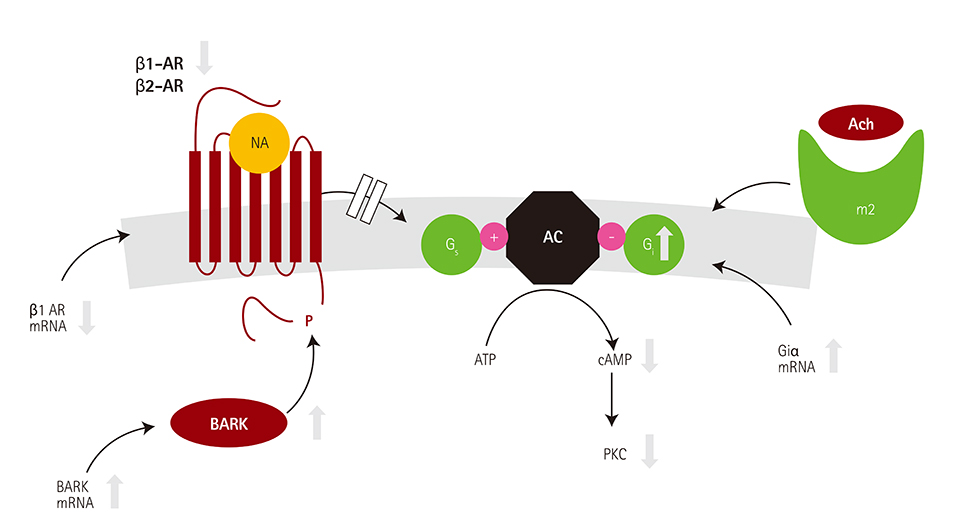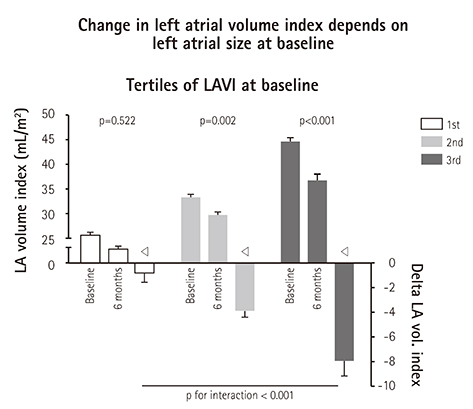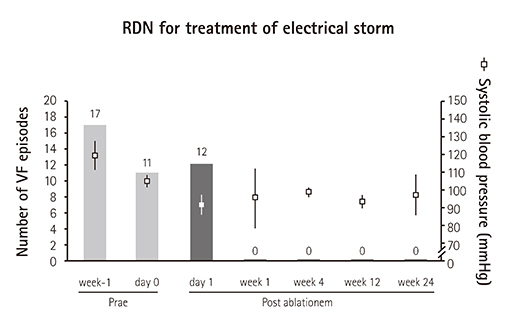Korean Circ J.
2017 Jan;47(1):9-15. 10.4070/kcj.2016.0231.
Renal Denervation for Chronic Heart Failure: Background and Pathophysiological Rationale
- Affiliations
-
- 1Departments of Internal Medicine III, Cardiology, Angiology, and Intensive Care, Saarland University Hospital, Homburg/Saar, Germany. michael.boehm@uks.eu
- KMID: 2365274
- DOI: http://doi.org/10.4070/kcj.2016.0231
Abstract
- The activation of the sympathetic nervous system is associated with cardiovascular hospitalizations and death in heart failure. Renal denervation has been shown to effectively reduce sympathetic overdrive in certain patients with uncontrolled hypertension. Pilot trials investigating renal denervation as a potential treatment approach for heart failure were initiated. Heart failure comorbidities like obstructive sleep apnea, metabolic syndrome and arrhythmias could also be targets for renal denervation, because these occurrences are also mediated by the activation of the sympathetic nervous system. Therefore, renal denervation in heart failure is worthy of further investigation, although its effectiveness still has to be proven. Herein, we describe the pathophysiological rationale and the effect of renal denervation on surrogates of the heart failure syndrome.
Keyword
MeSH Terms
Figure
Cited by 2 articles
-
Renal Denervation, Come Back Time?
Sang-Ho Jo
Korean Circ J. 2020;51(1):56-57. doi: 10.4070/kcj.2020.0479.An Open-label, Single-arm, Multicenter Feasibility Study Evaluating the Safety of Catheter-based Renal Denervation with DENEX™ in Patients with Uncontrolled Hypertension on Standard Medical Therapy
Chan Joon Kim, Kiyuk Chang, Byeong-Keuk Kim, Chang Gyu Park, Yangsoo Jang
Korean Circ J. 2020;51(1):43-55. doi: 10.4070/kcj.2020.0391.
Reference
-
1. Floras JS. Sympathetic nervous system activation in human heart failure: clinical implications of an updated model. J Am Coll Cardiol. 2009; 54:375–385.2. Holmer S, Rinne B, Eckardt KU, Le Hir M, Schricker K, Kaissling B, Riegger G, Kurtz A. Role of renal nerves for the expression of renin in adult rat kidney. Am J Physiol. 1994; 266:F738–F745.3. Hofmann U, Frantz S. Basic How can we cure a heart “in flame”? A translational view on inflammation in heart failure. Basic Res Cardiol. 2013; 108:356.4. Heineke J, Molkentin JD. Regulation of cardiac hypertrophy by intracellular signalling pathways. Nat Rev Mol Cell Biol. 2006; 7:589–600.5. Cohn JN, Levine TB, Olivari MT, et al. Plasma norepinephrine as a guide to prognosis in patients with chronic congestive heart failure. N Engl J Med. 1984; 311:819–823.6. Rector TS, Olivari MT, Levine TB, Francis GS, Cohn JN. Predicting survival for an individual with congestive heart failure using the plasma norepinephrine concentration. Am Heart J. 1987; 114:148–152.7. Francis GS, Benedict C, Johnstone DE, et al. Comparison of neuroendocrine activation in patients with left ventricular dysfunction with and without congestive heart failure. A substudy of the Studies of Left Ventricular Dysfunction (SOLVD). Circulation. 1990; 82:1724–1729.8. Esler M. The 2009 Carl Ludwig Lecture: Pathophysiology of the human sympathetic nervous system in cardiovascular diseases: the transition from mechanisms to medical management. J Appl Physiol. 2010; 108:227–237.9. DiBona GF, Sawin LL. Role of renal nerves in sodium retention of cirrhosis and congestive heart failure. Am J Physiol. 1991; 260:R298–R305.10. Campese VM. Neurogenic factors and hypertension in chronic renal failure. J Nephrol. 1997; 10:184–187.11. Böhm M, Linz D, Ukena C, Esler M, Mahfoud F. Renal denervation for the treatment of cardiovascular high risk-hypertension or beyond? Circ Res. 2014; 115:400–409.12. Huggett RJ, Scott EM, Gilbey SG, Stoker JB, Mackintosh AF, Mary DA. Impact of type 2 diabetes mellitus on sympathetic neural mechanisms in hypertension. Circulation. 2003; 108:3097–3101.13. Mancia G, Bousquet P, Elghozi JL, et al. The sympathetic nervous system and the metabolic syndrome. J Hypertens. 2007; 25:909–920.14. Sobotka PA, Krum H, Böhm M, Francis DP, Schlaich MP. The role of renal denervation in the treatment of heart failure. Curr Cardiol Rep. 2012; 14:285–292.15. Dunlap ME, Sobotka PA. Fluid re-distribution rather than accumulation causes most cases of decompensated heart failure. J Am Coll Cardiol. 2013; 62:165–166.16. Peppard PE, Young T, Palta M, Skatrud J. Prospective study of the association between sleep-disordered breathing and hypertension. N Engl J Med. 2000; 342:1378–1384.17. Logan AG, Perlikowski SM, Mente A, et al. High prevalence of unrecognized sleep apnoea in drug-resistant hypertension. J Hypertens. 2001; 19:2271–2277.18. McMurray JJ, Adamopoulos S, Anker SD, et al. ESC Guidelines for the diagnosis and treatment of acute and chronic heart failure 2012: The Task Force for the Diagnosis and Treatment of Acute and Chronic Heart Failure 2012 of the European Society of Cardiology. Developed in collaboration with the Heart Failure Association (HFA) of the ESC. Eur Heart J. 2012; 33:1787–1847.19. Ljungqvist A, Wågermark J. The adrenergic innervation of intrarenal glomerular and extra-glomerular circulatory routes. Nephron. 1970; 7:218–229.20. Stella A, Zanchetti A. Functional role of renal afferents. Physiol Rev. 1991; 71:659–682.21. Katholi RE, Whitlow PL, Hageman GR, Woods WT. Intrarenal adenosine produces hypertension by activating the sympathetic nervous system via the renal nerves in the dog. J Hypertens. 1984; 2:349–359.22. Esler M, Lambert G, Jennings G. Regional norepinephrine turnover in human hypertension. Clin Exp Hypertens A. 1989; Suppl 1. 75–89.23. Hausberg M, Kosch M, Harmelink P, et al. Sympathetic nerve activity in end-stage renal disease. Circulation. 2002; 106:1974–1979.24. Swedberg K, Viquerat C, Rouleau JL, et al. Comparison of myocardial catecholamine balance in chronic congestive heart failure and in angina pectoris without failure. Am J Cardiol. 1984; 54:783–786.25. Böhm M, Beuckelmann D, Brown L, et al. Reduction of beta-adrenoceptor density and evaluation of positive inotropic responses in isolated, diseased human myocardium. Eur Heart J. 1988; 9:844–852.26. Böhm M, Gierschik P, Jakobs KH, et al. Increase of Gi alpha in human hearts with dilated but not ischemic cardiomyopathy. Circulation. 1990; 82:1249–1265.27. Goldstein DS, Brush JE Jr, Eisenhofer G, Stull R, Esler M. In vivo measurement of neuronal uptake of norepinephrine in the human heart. Circulation. 1988; 78:41–48.28. Böhm M, La Rosée K, Schwinger RH, Erdmann E. Evidence for reduction of norepinephrine uptake sites in the failing human heart. J Am Coll Cardiol. 1995; 25:146–153.29. Hasking GJ, Esler MD, Jennings GL, Burton D, Johns JA, Korner PI. Norepinephrine spillover to plasma in patients with congestive heart failure: evidence of increased overall and cardiorenal sympathetic nervous activity. Circulation. 1986; 73:615–621.30. Petersson M, Friberg P, Eisenhofer G, Lambert G, Rundqvist B. Long-term outcome in relation to renal sympathetic activity in patients with chronic heart failure. Eur Heart J. 2005; 26:906–913.31. Page IH. The effect on renal efficiency of lowering arterial blood pressure in cases of essential hypertension and nephritis. J Clin Invest. 1934; 13:909–915.32. Page IH, Heuer GJ. The effect of renal denervation on the level of arterial blood pressure and renal function in essential hypertension. J Clin Invest. 1935; 14:27–30.33. Smithwick RH, Thompson JE. Splanchnicectomy for essential hypertension; results in 1,266 cases. J Am Med Assoc. 1953; 152:1501–1504.34. Krum H, Schlaich M, Whitbourn R, et al. Catheter-based renal sympathetic denervation for resistant hypertension: a multicentre safety and proof-of-principle cohort study. Lancet. 2009; 373:1275–1281.35. Symplicity HTN-1 Investigators. Catheter-based renal sympathetic denervation for resistant hypertension: durability of blood pressure reduction out to 24 months. Hypertension. 2011; 57:911–917.36. Hering D, Mahfoud F, Walton AS, et al. Renal denervation in moderate to severe CKD. J Am Soc Nephrol. 2012; 23:1250–1257.37. Symplicity HTN-2 Investigators. Esler MD, Krum H, Sobotka PA, Schlaich MP, Schmieder RE, Böhm M. Renal sympathetic denervation in patients with treatment-resistant hypertension (The Symplicity HTN-2 Trial): a randomised controlled trial. Lancet. 2010; 376:1903–1909.38. Esler MD, Krum H, Schlaich M, Schmieder RE, Böhm M, Sobotka PA. Symplicity HTN-2 Investigators. Renal sympathetic denervation for treatment of drug-resistant hypertension: one-year results from the Symplicity HTN-2 randomized, controlled trial. Circulation. 2012; 126:2976–2982.39. Ukena C, Mahfoud F, Kindermann I, et al. Cardiorespiratory response to exercise after renal sympathetic denervation in patients with resistant hypertension. J Am Coll Cardiol. 2011; 58:1176–1182.40. Brandt MC, Reda S, Mahfoud F, Lenski M, Böhm M, Hoppe UC. Effects of renal sympathetic denervation on arterial stiffness and central hemodynamics in patients with resistant hypertension. J Am Coll Cardiol. 2012; 60:1956–1965.41. Brandt MC, Mahfoud F, Reda S, et al. Renal sympathetic denervation reduces left ventricular hypertrophy and improves cardiac function in patients with resistant hypertension. J Am Coll Cardiol. 2012; 59:901–909.42. Davies JE, Manisty CH, Petraco R, et al. First-in-man safety evaluation of renal denervation for chronic systolic heart failure: primary outcome from REACH-Pilot study. Int J Cardiol. 2013; 162:189–192.43. Fallick C, Sobotka PA, Dunlap ME. Sympathetically mediated changes in capacitance: redistribution of the venous reservoir as a cause of decompensation. Circ Heart Fail. 2011; 4:669–675.44. Linz D, Schotten U, Neuberger HR, Böhm M, Wirth K. Negative tracheal pressure during obstructive respiratory events promotes atrial fibrillation by vagal activation. Heart Rhythm. 2011; 8:1436–1443.45. Linz D, Mahfoud F, Schotten U, et al. Renal sympathetic denervation suppresses postapneic blood pressure rises and atrial fibrillation in a model for sleep apnea. Hypertension. 2012; 60:172–178.46. Ahmed H, Miller MA, Dukkipati SR, et al. Adjunctive renal sympathetic denervation to modify hypertension as upstream therapy in the treatment of atrial fibrillation (H-FIB) study: clinical background and study design. J Cardiovasc Electrophysiol. 2013; 24:503–509.47. Schirmer SH, Sayed MM, Reil JC, et al. Improvements in left ventricular hypertrophy and diastolic function following renal denervation: effects beyond blood pressure and heart rate reduction. J Am Coll Cardiol. 2014; 63:1916–1923.48. Mahfoud F, Urban D, Teller D, et al. Effect of renal denervation on left ventricular mass and function in patients with resistant hypertension: data from a multi-centre cardiovascular magnetic resonance imaging trial. Eur Heart J. 2014; 35:2224–2231.49. Schirmer SH, Sayed MM, Reil JC, et al. Atrial remodeling following catheter-based renal denervation occurs in blood pressure- and heart rate-independent manner. JACC Cardiovasc Interv. 2015; 8:972–980.50. Linz D, van Hunnik A, Hohl M, et al. Catheter-based renal denervation reduces atrial nerve sprouting and complexity of atrial fibrillation in goats. Circ Arrhythm Electrophysiol. 2015; 8:466–474.51. Linz D, Wirth K, Ukena C, et al. Renal denervation suppresses ventricular arrhythmias during acute ventricular ischemia in pigs. Heart Rhythm. 2013; 10:1525–1530.52. Ukena C, Bauer A, Mahfoud F, et al. Renal sympathetic denervation for treatment of electrical storm: first-in-man experience. Clin Res Cardiol. 2012; 101:63–67.53. Ukena C, Mahfoud F, Ewen S, et al. Renal denervation for treatment of ventricular arrhythmias: data from an international multicenter registry. Clin Res Cardiol. 2016; 105:873–879.54. Schlaich MP, Bart B, Hering D, et al. Feasibility of catheter-based renal nerve ablation and effects on sympathetic nerve activity and blood pressure in patients with end-stage renal disease. Int J Cardiol. 2013; 168:2214–2220.55. Mahfoud F, Cremers B, Janker J, et al. Renal hemodynamics and renal function after catheter-based renal sympathetic denervation in patients with resistant hypertension. Hypertension. 2012; 60:419–424.56. Linz D, Hohl M, Nickel A, et al. Effect of renal denervation on neurohumoral activation triggering atrial fibrillation in obstructive sleep apnea. Hypertension. 2013; 62:767–774.57. Mahfoud F, Schlaich M, Kindermann I, et al. Effect of renal sympathetic denervation on glucose metabolism in patients with resistant hypertension: a pilot study. Circulation. 2011; 123:1940–1946.58. Tzafriri AR, Mahfoud F, Keating JH. Innervation patterns may limit response to endovascular renal denervation. J Am Coll Cardiol. 2014; 64:1079–1087.59. Mahfoud F, Böhm M, Azizi M, et al. Proceedings from the European clinical consensus conference for renal denervation: considerations on future clinical trial design. Eur Heart J. 2015; 36:2219–2227.60. Kandzari DE, Kario K, Mahfoud F, et al. The SPYRAL HTN Global Clinical Trial Program: Rationale and design for studies of renal denervation in the absence (SPYRAL HTN OFF-MED) and presence (SPYRAL HTN ON-MED) of antihypertensive medications. Am Heart J. 2016; 171:82–91.61. Donazzan L, Mahfoud F, Ewen S, et al. Effects of catheter-based renal denervation on cardiac sympathetic activity and innervation in patients with resistant hypertension. Clin Res Cardiol. 2016; 105:364–371.
- Full Text Links
- Actions
-
Cited
- CITED
-
- Close
- Share
- Similar articles
-
- Percutaneous Renal Sympathetic Denervation for the Treatment of Resistant Hypertension with Heart Failure: First Experience in Korea
- Clinical Experience of Hemodialysis on Three Cases of Renal Failure using Kill Type Artificial Kidney
- The Serum NPN, BUN and Creatinine Values in Chronic Congestive Heart Failure
- Chronic kidney disease and risk factors responsible for sudden cardiac death: a whiff of hope?
- Effectiveness of renal denervation in the treatment of hypertension: a literature review





